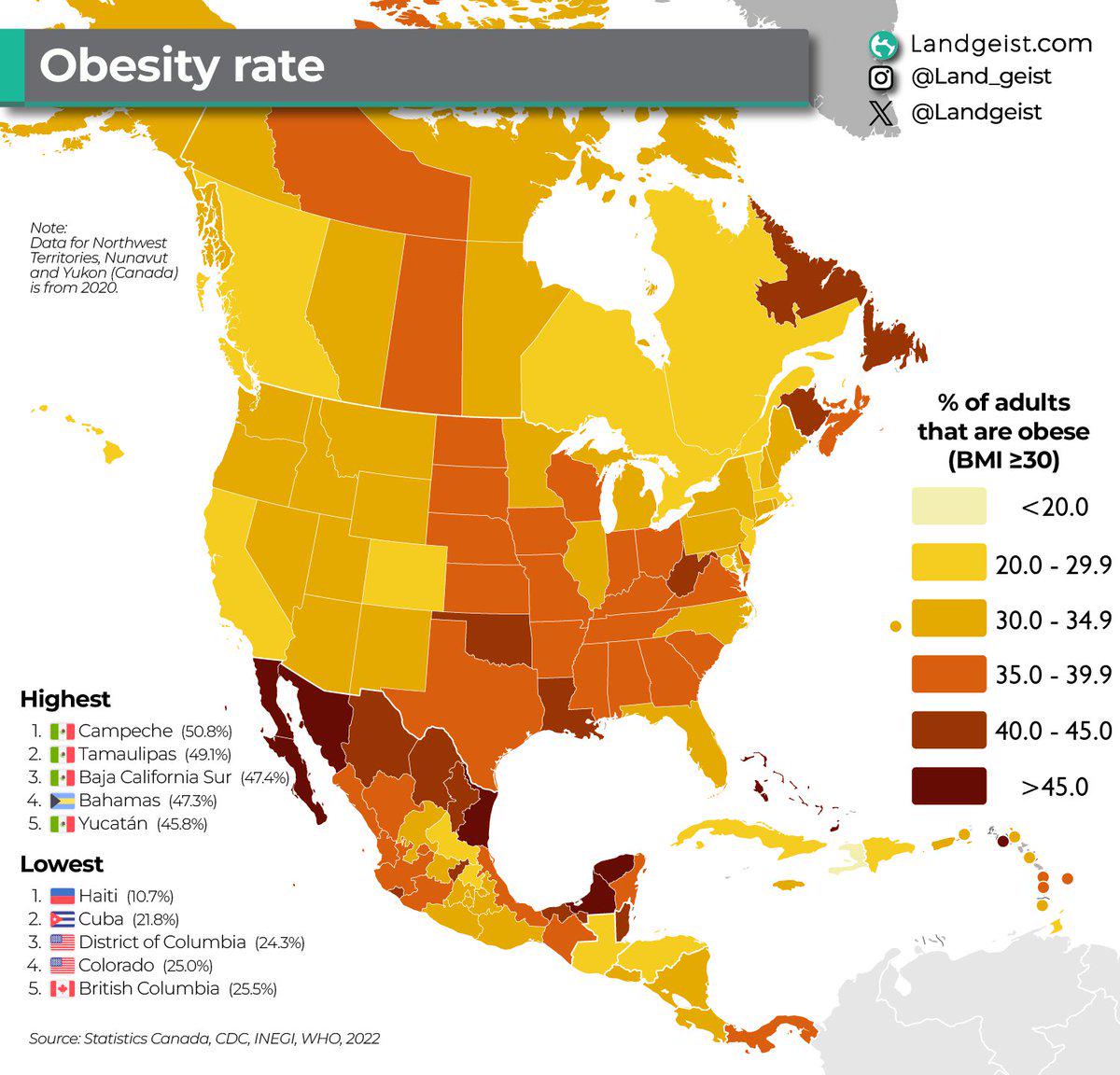Obesity Rate Map in Northern & Central America


David Chen
Data Visualization Specialist
David Chen is an expert in transforming complex geographic datasets into compelling visual narratives. He combines his background in computer science ...
Geographic Analysis
What This Map Shows
The "Obesity Rate in Northern & Central America [2022 data]" map provides a comprehensive visual representation of the obesity rates across various countries in these regions. The data highlights the prevalence of obesity, measured by the percentage of the population with a body mass index (BMI) of 30 or more, a significant health indicator affecting millions globally. This alarming trend reflects not just individual health issues but also broader societal challenges, including lifestyle choices, economic factors, and access to health resources.
Deep Dive into Obesity Rates
Obesity is a complex issue influenced by a myriad of factors ranging from genetics and metabolism to environment and culture. In Northern and Central America, the rising rates of obesity have become a pressing public health concern, particularly in the wake of the COVID-19 pandemic, which exacerbated sedentary lifestyles and unhealthy eating habits.
Interestingly, the United States consistently ranks among the highest in obesity rates globally, with figures indicating that over 36% of adults are classified as obese. This phenomenon is often attributed to a combination of factors, including the widespread availability of processed foods, larger portion sizes, and a culture that increasingly prioritizes convenience over nutritional value. Moreover, socioeconomic status plays a critical role—lower-income areas often have limited access to healthy food options and safe environments for physical activity.
However, the map reveals that while the U.S. holds a significant portion of the obesity crisis, countries in Central America, such as Mexico, are also experiencing alarming rates. Mexico has seen obesity rates rise dramatically, with about 28% of its adult population classified as obese. The traditional Mexican diet, rich in corn and beans, is being overshadowed by an influx of fast food and sugary beverages, which contribute to this troubling trend.
Another notable area is the Caribbean, where countries like Barbados and Jamaica are grappling with obesity rates that reflect similar patterns. In Jamaica, for instance, the obesity rate has been reported at around 25%, highlighting a growing public health issue that calls for urgent attention. The cultural shift towards Western diets has been influential here, too, leading to lifestyle changes that prioritize convenience over health.
Regional Analysis
Examining the map closely, we can observe significant variations in obesity rates across different regions. In the Northern region, the United States and Canada display higher obesity prevalence compared to their counterparts in Central America and the Caribbean. Canada, for instance, has made strides in public health campaigns to combat obesity, resulting in lower rates compared to the U.S., though it still faces challenges, with approximately 27% of its population classified as obese.
Central America presents a mixed picture. Countries like Guatemala and Honduras are on the lower end of the spectrum, with obesity rates around 24% and 29%, respectively. This is often linked to dietary practices and lifestyle choices that remain more traditional and less influenced by fast-food culture. Conversely, countries like Panama show a sharp increase, with obesity rates nearing 31% as urbanization and economic development lead to lifestyle changes.
Interestingly, the Caribbean islands display a unique pattern, where despite smaller populations, the obesity crisis is pronounced. Nations like Saint Kitts and Nevis and Antigua and Barbuda report rates of 32% and 34%, respectively, driven largely by reliance on imported foods and a lack of physical activity.
Significance and Impact
Understanding obesity rates in Northern and Central America is crucial, not only for public health officials but also for policymakers and communities. High obesity rates lead to increased healthcare costs and a higher prevalence of related health issues, such as diabetes, heart disease, and certain cancers. Furthermore, the economic burden of obesity can strain healthcare systems, affecting productivity and quality of life.
Current trends indicate that if proactive measures are not taken, obesity rates could continue to rise. Public health initiatives focusing on education, access to healthy foods, and promoting physical activity are essential. Have you noticed that many communities are starting to prioritize local farmer's markets or nutrition education? These are steps in the right direction, but it's vital that they continue to gain momentum.
Moreover, addressing the obesity crisis requires a multifaceted approach that considers cultural, economic, and social factors. By fostering environments that encourage healthy choices and physical activity, we can work towards reversing this trend. The future of public health in Northern and Central America depends on our collective response to the challenges posed by obesity, making it an urgent issue that deserves our attention and action.
Visualization Details
- Published
- August 10, 2025
- Views
- 124
Comments
Loading comments...